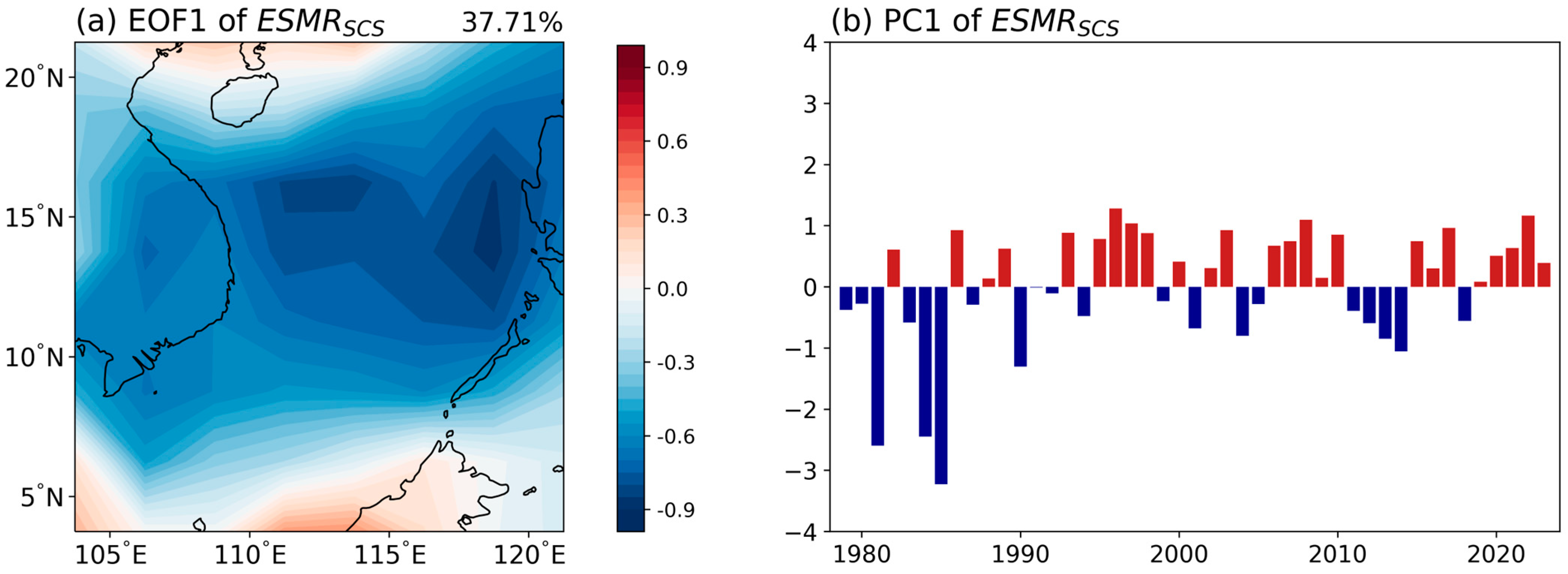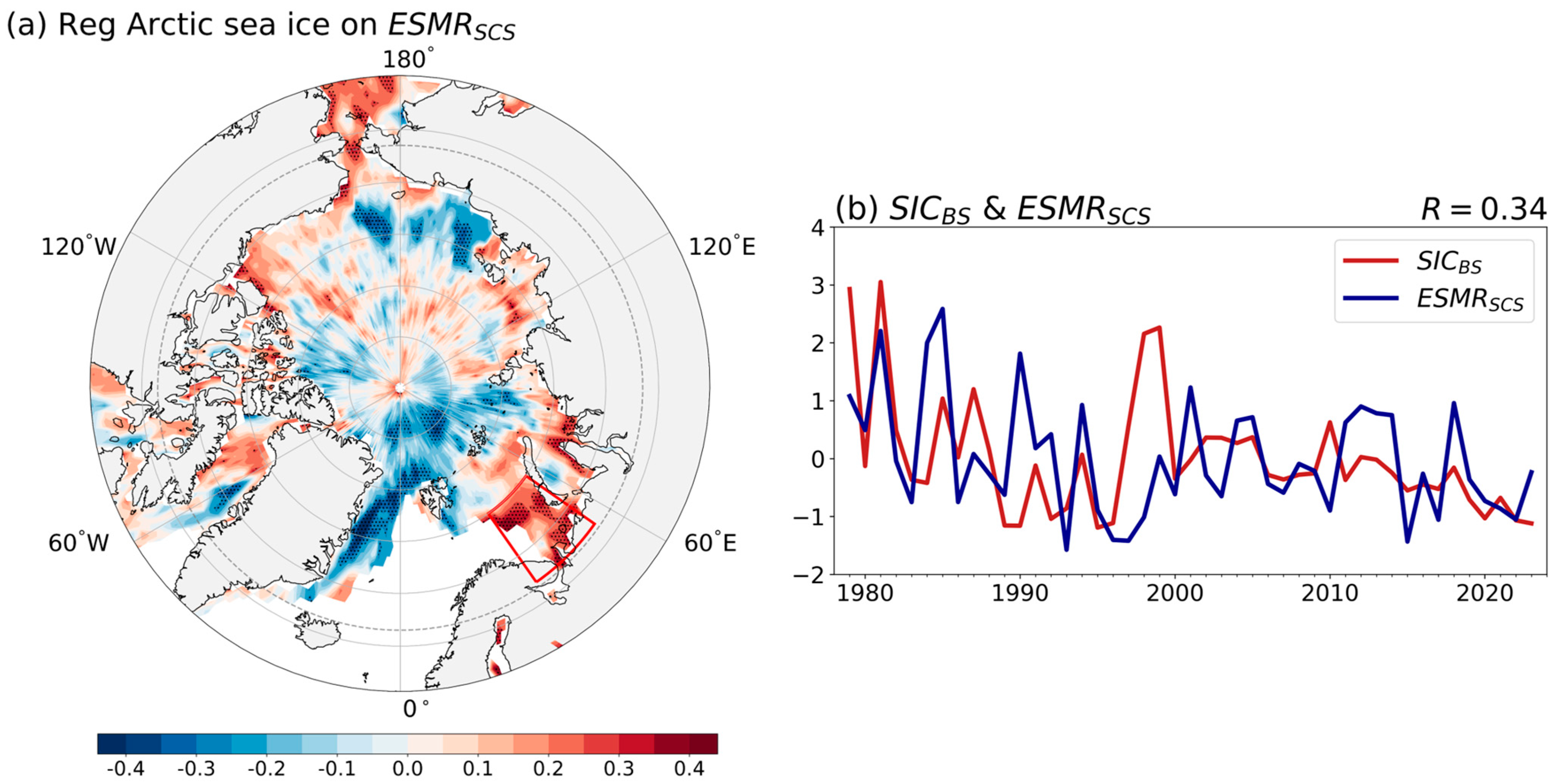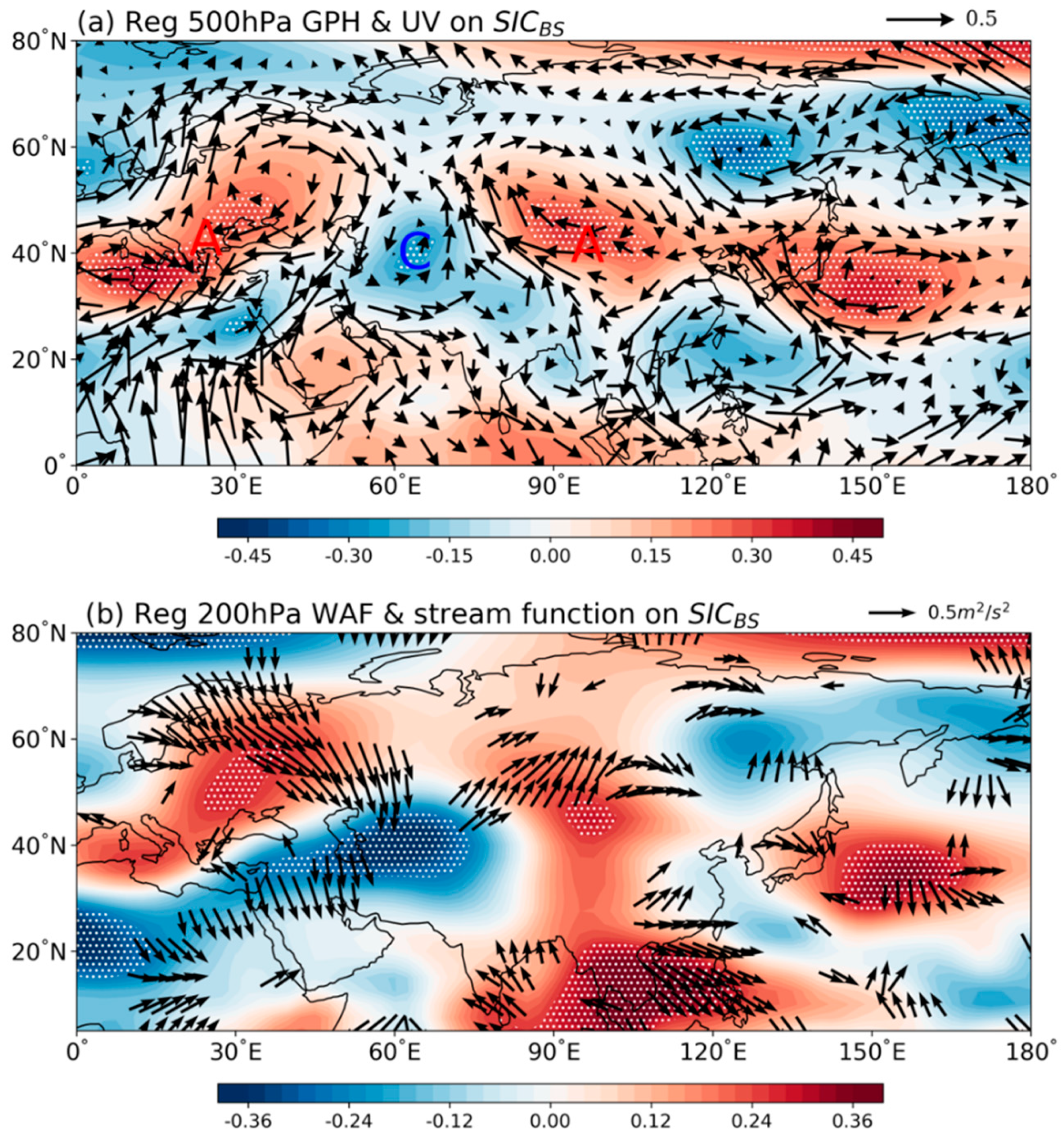Connection between Barents Sea Ice in May and Early Summer Monsoon Rainfall in the South China Sea and Its Possible Mechanism
Abstract
:1. Introduction
2. Materials and Methods
2.1. Data
2.2. Definition of the SCSSM Index
2.3. Plumb’s Wave Activity Flux
2.4. Vertical Integral of Water Vapour Flux
2.5. Composite Analysis and Student’s t-Test
2.6. Numerical Model
3. Results
3.1. Relationship between Arctic Sea Ice and the ESMRSCS
3.2. Possible Mechanism of SICBS in May Affecting the ESMRSCS
3.3. Numerical Experiments
4. Conclusions and Discussion
4.1. Conclusions
4.2. Discussion
Author Contributions
Funding
Institutional Review Board Statement
Informed Consent Statement
Data Availability Statement
Acknowledgments
Conflicts of Interest
References
- Bekryaev, R.V.; Polyakov, I.V.; Alexeev, V.A. Role of polar amplification in long-term surface air temperature variations and modern Arctic warming. J. Clim. 2010, 23, 3888–3906. [Google Scholar] [CrossRef]
- Gao, Y.; Sun, J.; Li, F.; He, S.; Sandven, S.; Yan, Q.; Zhang, Z.; Lohmann, K.; Keenlyside, N.; Furevik, T.; et al. Arctic Sea ice and Eurasian climate: A review. Adv. Atmos. Sci. 2015, 32, 92–114. [Google Scholar] [CrossRef]
- Zhang, L.; Zhang, Z.; Li, Q.; Wu, H. Abnormal change trend of Arctic Sea ice in recent 30 years. Chin. J. Polym. Sci. 2009, 21, 344–352. (In Chinese) [Google Scholar]
- IPCC. Climate Change 2021: The Physical Science Basis. Contribution of Working Group Ito the Sixth Assessment Report of the Intergovernmental Panel on Climate Change; IPCC: Geneva, Switzerland, 2021. [Google Scholar]
- Song, H.; Sun, Z. Temporal and spatial distribution of summer drought and flood in North China and its relationship with Arctic Sea ice. Trans. Atmos. Sci. 2003, 26, 289–295. (In Chinese) [Google Scholar]
- Wu, B.; Zhang, R.; D’Arrigo, R.; Sun, J. On the Relationship between Winter Sea Ice and Summer Atmospheric Circulation over Eurasia. J. Clim. 2013, 26, 5523–5536. [Google Scholar] [CrossRef]
- You, C.; Li, Y.; Song, W. Effects of autumn Arctic sea ice on winter extreme low temperature events over China from 1978 to 2017. J. Lanzhou Univ. (Nat. Sci. Ed.) 2022, 58, 510–527. (In Chinese) [Google Scholar]
- Zhang, M.; Sun, J.; Gao, Y. Possible influence and prediction value of sea ice anomaly in Davis Channels-Baffin Bay region on spring extreme precipitation frequency in eastern China. Earth Sci. Front. 2022, 29, 401–409. (In Chinese) [Google Scholar]
- Zhang, X.; Ding, S.; Pang, X.; Zhang, X.; Liu, L. Relationship between Arctic sea ice melt and spring precipitation over East Asia. J. Glaciol. Geocryol. 2023, 45, 655–664. (In Chinese) [Google Scholar]
- Zeng, G.; Sun, Z.; Min, J. Study on the relationship between interannual variation of sea ice extent in winter Davis Strait and East Asian climate. J. Nanjing Inst. Meteorol. 2001, 24, 476–482. (In Chinese) [Google Scholar]
- Li, F.; Wang, H. Relationship between Bering Sea Ice Cover and East Asian Winter Monsoon Year-to-Year Variations. Adv. Atmos. Sci. 2013, 30, 48–56. [Google Scholar] [CrossRef]
- Yang, X.; Xie, Q.; Huang, S. Numerical simulation of the impact of Arctic ice anomalies on the Asian summer monsoon. Acta Oceanol. Sin. 1994, 16, 34–40. (In Chinese) [Google Scholar]
- Zhao, P.; Zhang, X.; Zhou, X.; Ikeda, M.; Yin, Y. The sea ice extent anomaly in the North Pacific and its impact on the East Asian summer monsoon rainfall. J. Clim. 2004, 17, 3434–3447. [Google Scholar] [CrossRef]
- Guo, D.; Gao, Y.; Bethke, I.; Gong, D.; Johannessen, O.M.; Wang, H. Mechanism on how the spring Arctic Sea ice impacts the East Asian summer monsoon. Theor. Appl. Climatol. 2014, 115, 107–119. [Google Scholar] [CrossRef]
- England, M.R.; Polvani, L.M.; Sun, L.; Deser, C. Tropical climate responses to projected Arctic and Antarctic sea-ice loss. Nature Geosci. 2020, 13, 275–281. [Google Scholar] [CrossRef]
- Wang, K.; Deser, C.; Sun, L.; Tomas, R.A. Fast Response of the Tropics to an Abrupt Loss of Arctic Sea Ice via Ocean Dynamics. Geophys. Res. Lett. 2018, 45, 4264–4272. [Google Scholar] [CrossRef]
- Sun, L.; Deser, C.; Tomas, R.A.; Alexander, M. Global Coupled Climate Response to Polar Sea Ice Loss: Evaluating the Effectiveness of Different Ice-Constraining Approaches. Geophys. Res. Lett. 2023, 47, e2019GL085788. [Google Scholar] [CrossRef]
- Chen, S.; Chen, W.; Yu, B.; Wu, L.; Chen, L.; Li, Z.; Aru, H.; Huangfu, J. Impact of the winter Arctic sea ice anomaly on the following summer tropical cyclone genesis frequency over the western North Pacific. Clim. Dyn. 2023, 61, 3971–3988. [Google Scholar] [CrossRef]
- Chatterjee, S.; Ravichandran, M.; Murukesh, N.; Raj, N.P.; Johannessen, O.M. A possible relation between Arctic sea ice and late season Indian Summer Monsoon Rainfall extremes. Npj Clim. Atmos. Sci. 2021, 4, 36. [Google Scholar] [CrossRef]
- Lau, K.M.; Yang, S. Climatology and interannual variability of the southeast Asian summer monsoon. Adv. Atmos. Sci. 1997, 14, 141–162. [Google Scholar] [CrossRef]
- Wang, B.; Lin, H.; Zhang, Y.; Lu, M.M. Definition of South China Sea monsoon onset and commencement of the East Asia summer monsoon. J. Clim. 2004, 17, 699–710. [Google Scholar] [CrossRef]
- Zheng, B.; Li, C.; Lin, A.; Gu, D.; He, C. Definition and application of activity indicators for the South China Sea summer monsoon. J. Trop. Meteorol. 2016, 32, 433–443. (In Chinese) [Google Scholar]
- Hu, P.; Chen, W.; Chen, S.; Liu, Y.; Huang, R. Impact of the March Arctic Oscillation on the South China Sea summer monsoon onset. Int. J. Climatol. 2020, 41, E3239–E3248. [Google Scholar] [CrossRef]
- Hu, P.; Chen, W.; Chen, S.; Wang, L.; Liu, Y. The Weakening Relationship between ENSO and the South China Sea Summer Monsoon Onset in Recent Decades. Adv. Atmos. Sci. 2022, 39, 443–455. [Google Scholar] [CrossRef]
- Kalnay, E.; Kanamitsu, M.; Kistler, R.; Collins, W.G. The NCEP/NCAR 40-year reanalysis project. Bull. Amer. Meteor. Soc. 1996, 77, 437–472. [Google Scholar] [CrossRef]
- Rayner, N.A.; Parker, D.E.; Horton, E.B.; Folland, C.K.; Alexander, L.V.; Rowell, D.P.; Kent, E.C.; Kaplan, A. Global analyses of sea surface temperature, sea ice, and night marine air temperature since the late nineteenth century. J. Geophys. Res. 2003, 108, 1063–1082. [Google Scholar] [CrossRef]
- Xie, P.; Arkin, P.A. Global precipitation: A 17-year monthly analysis based on gauge observations, satellite estimates, and numerical model outputs Bull. Am. Meteor Soc. 1997, 78, 2539–2558. [Google Scholar] [CrossRef]
- Webster, P.J.; Yang, S. Monsoon and ENSO: Selectively interactive systems. Quart. J. Roy. Meteor. Soc. 1992, 118, 877–926. [Google Scholar] [CrossRef]
- Li, C.; Zhang, L. Summer Monsoon Activities in the South China Sea and Its Impacts. Chin. J. Atmos. Sci. 1999, 23, 257–266. (In Chinese) [Google Scholar] [CrossRef]
- Wu, S.; Liang, J. Intensity index of the South China Sea summer monsoon and its variation characteristics. J. Trop. Meteorol. 2001, 17, 337–344. [Google Scholar]
- Parthasarathy, B.; Munot, A.A.; Kothawale, D.R. All-India monthly and seasonal rainfall series: 1871–1993. Theor. Appl. Climatol. 1994, 49, 217–224. [Google Scholar] [CrossRef]
- Liang, J.; Wu, S. A Study of Southwest Monsoon Onset Date over the South China Sea and Its Impact Factors. Chin. J. Atmos. Sci. 2002, 26, 829–844. (In Chinese) [Google Scholar]
- Li, D.; Jiang, Y.; Zhang, L.; Wang, H.; Li, X. Onset and retreat dates of the South China Sea summer monsoon and their relationships with the monsoon intensity in the context of climate warming. J. Trop. Meteorol. 2016, 22, 362–373. (In Chinese) [Google Scholar]
- Plumb, R.A. On the three-dimensional propagation of stationary waves. J. Atmos. Sci. 1985, 42, 217–229. [Google Scholar] [CrossRef]
- Ding, Y. Advanced Weather Science; China Meteorological Press: Beijing, China, 2005; 585p. [Google Scholar]
- Fisher, B. Guinness, Gosset, Fisher, and Small Samples. Stat. Sci. 1987, 1, 45–52. [Google Scholar]
- Neale, R.B.; Gettelman, A.; Park, S.; Conley, A.J.; Kinnison, D.; Marsh, D.; Smith, A.; Vitt, F.; Morrison, H.; Cameron-smith, P.; et al. Description of the NCAR Community Atmosphere Model (CAM 5.0). In NCAR Tech. Note NCAR/TN-486+ STR; NCAR Publication Office: Boulder, CO, USA, 2010; 274p. [Google Scholar]
- Bretherton, C.S.; Park, S. A new moist turbulence parameterization in the community atmosphere model. J. Clim. 2009, 12, 3422–3448. [Google Scholar] [CrossRef]
- Duan, S.; Jiang, Z. Sensitivity of Northern Hemisphere atmosphere in winter to sea ice anomalies in the Barents Sea in autumn and winter. Acta Meteorol. Sin. 2021, 79, 209–228. (In Chinese) [Google Scholar]
- He, S.; Gao, Y.; Furevik, T.; Wang, H.; Li, F. Teleconnection between sea ice in the Barents Sea in June and the Silk Road, Pacific–Japan and East Asian rainfall patterns in August. Adv. Atmos. Sci. 2018, 35, 52–64. [Google Scholar] [CrossRef]
- North, G.R.; Bell, T.L.; Cahalan, R.F.; Moeng, F.J. Sampling errors in the estimation of empirical orthogonal functions. Mon. Weather Rev. 1982, 110, 699–706. [Google Scholar] [CrossRef]
- Huang, S. Study on the east-west movement of the subtropical high and its forecast. Acta Meteorol. Sin. 1963, 33, 320–332. (In Chinese) [Google Scholar]
- Tao, S.; Wei, J. The Westward, Northward Advance of the Subtropical High over the West Pacific in Summer. J. Appl. Meteor. 2006, 05, 513–525. [Google Scholar]
- Zhao, J.; Feng, G.; Yang, J.; Zhi, R.; Wang, Q. Analysis of the distribution of the large scale drought/flood of summer in China under different types of the western Pacific subtropical high. Acta Meteorol. Sin. 2012, 70, 1021–1031. (In Chinese) [Google Scholar]
- Yu, D.; Zhang, Y.; Zhao, C.; Wan, L.; Guo, X. Correlation between the subtropical high abnormal longitudinal position and the East Asian summer monsoon system. Trans. Atmos. Sci. 2014, 37, 304–312. (In Chinese) [Google Scholar]
- Screen, J.A.; Simmonds, I.; Deser, C.; Tomas, R. The atmospheric response to three decades of observed Arctic sea ice loss. J. Clim. 2013, 26, 1230–1248. [Google Scholar] [CrossRef]
- Wallace, J.M.; Gutzler, D.S. Teleconnections in the geopotential height field during the Northern Hemisphere winter. Mon. Weather Rev. 1981, 109, 784–812. [Google Scholar] [CrossRef]








| SEU | ESMRSCS | |
|---|---|---|
| WPSHA | −0.36 | −0.32 |
| WPSHI | −0.33 | −0.28 |
| Experiments | Numbers | Years | Description |
|---|---|---|---|
| HBS | 30 | 1 | The May SIC in the BS (66°–75° N,35° E–55° E) is the mean SIC of PSIC years, while other regions are climatological SIC/SST. For other seasons, the model is forced by climatological SIC/SST. |
| LBS | 30 | 1 | Same as the HBS, but the May SIC in the BS is the mean SIC of NSIC years. |
Disclaimer/Publisher’s Note: The statements, opinions and data contained in all publications are solely those of the individual author(s) and contributor(s) and not of MDPI and/or the editor(s). MDPI and/or the editor(s) disclaim responsibility for any injury to people or property resulting from any ideas, methods, instructions or products referred to in the content. |
© 2024 by the authors. Licensee MDPI, Basel, Switzerland. This article is an open access article distributed under the terms and conditions of the Creative Commons Attribution (CC BY) license (https://creativecommons.org/licenses/by/4.0/).
Share and Cite
Li, F.; Zeng, G.; Zhang, S.; Hamadlnel, M. Connection between Barents Sea Ice in May and Early Summer Monsoon Rainfall in the South China Sea and Its Possible Mechanism. Atmosphere 2024, 15, 433. https://doi.org/10.3390/atmos15040433
Li F, Zeng G, Zhang S, Hamadlnel M. Connection between Barents Sea Ice in May and Early Summer Monsoon Rainfall in the South China Sea and Its Possible Mechanism. Atmosphere. 2024; 15(4):433. https://doi.org/10.3390/atmos15040433
Chicago/Turabian StyleLi, Fangyu, Gang Zeng, Shiyue Zhang, and Monzer Hamadlnel. 2024. "Connection between Barents Sea Ice in May and Early Summer Monsoon Rainfall in the South China Sea and Its Possible Mechanism" Atmosphere 15, no. 4: 433. https://doi.org/10.3390/atmos15040433
APA StyleLi, F., Zeng, G., Zhang, S., & Hamadlnel, M. (2024). Connection between Barents Sea Ice in May and Early Summer Monsoon Rainfall in the South China Sea and Its Possible Mechanism. Atmosphere, 15(4), 433. https://doi.org/10.3390/atmos15040433





